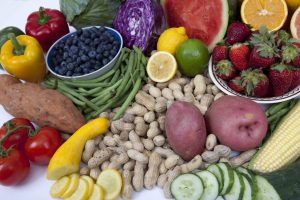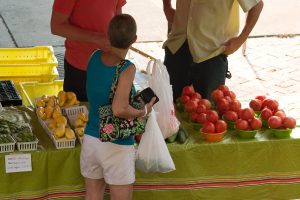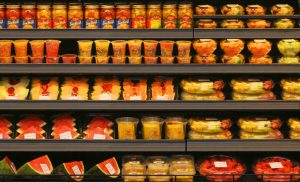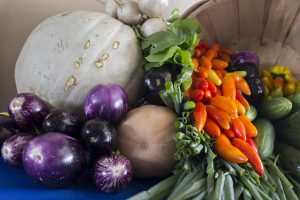This year, my partner’s and my goal is to eat more fresh fruits and vegetables. She’s been vegetarian more than half her life, so she has a lot of practice with this. I, on the other hand, still need some help figuring out what I want besides the standard apples and bananas.

Luckily, an Ask IFAS series has the answers! The UF/IFAS Food Science and Human Nutrition Department maintains the Shopping for Health series (also available in Spanish), which covers not only tips for selecting fresh fruits and vegetables, but ideas of what to look for in frozen meals and breakfast cereals, milk and yogurt, and herbs and spices. There are articles focusing on specific nutrients like vitamin D, sodium, and added fiber. There’s even an article about meal planning as a person living alone, a topic I wish I knew more about in my twenties!
Let’s look at some of their recommendations.
Start with what you like
It may seem obvious, but don’t waste your time and money on foods you don’t like! Buying kale and cauliflower won’t up your vegetable intake if they taste bad to you. That doesn’t mean you shouldn’t experiment once you have your staples set, but it’s okay—and easier on your wallet—to admit you just don’t like a food.
Buy produce in season
Produce in season usually is cheaper and tastes better. Think of how bright and fresh a Honeycrisp apple tastes in the fall. Plus, by following the seasons, you can cut through any analysis paralysis presented by the abundance of the supermarket produce section. Don’t know what to buy? Check the Seasonal Food Guide for your region.
Don’t forget about prepackaged produce
 Let’s face it: some produce is such a pain to prepare that sometimes, we just don’t want to bother. I love butternut squash roasted in grain bowls or in a soup or a stew, but I hate peeling it, seeding it, and then chunking it. Thankfully, many grocery stores carry prewashed and sliced fresh fruits and vegetables, like melons and squash. They do cost a little more—someone has to pay for that extra labor and packaging, after all—but if the goal is to eat more veggies, don’t discount the option.
Let’s face it: some produce is such a pain to prepare that sometimes, we just don’t want to bother. I love butternut squash roasted in grain bowls or in a soup or a stew, but I hate peeling it, seeding it, and then chunking it. Thankfully, many grocery stores carry prewashed and sliced fresh fruits and vegetables, like melons and squash. They do cost a little more—someone has to pay for that extra labor and packaging, after all—but if the goal is to eat more veggies, don’t discount the option.
Similarly, don’t forget about canned and frozen fruits and veggies. They contain the same nutrients as fresh fruit, but last longer before opened or thawed. They’re not everyone’s preference—my partner can’t stand canned corn, whereas I can’t taste whatever it is she doesn’t like—but they’re worth experimenting with to find out.
Put color on your plate
A colorful array of fruits and veggies is not only key to a balanced, nutritious diet—“vegetables with the brightest colors often have the most vitamins”—but it also makes your meal more appetizing. Food that looks good will make you want to eat it.
Buy produce that sounds good together
 Try as you might to plan your shopping trip perfectly, there are almost always some leftover pieces of produce. If you buy fruits and vegetables that sound like they taste good together, you can come up with some surprisingly delicious meals, whether a tossed salad or the “Leftover Vegetable Soup” recommended in the “Menu for One” article. (I made that soup for dinner the other night. It was a big hit.)
Try as you might to plan your shopping trip perfectly, there are almost always some leftover pieces of produce. If you buy fruits and vegetables that sound like they taste good together, you can come up with some surprisingly delicious meals, whether a tossed salad or the “Leftover Vegetable Soup” recommended in the “Menu for One” article. (I made that soup for dinner the other night. It was a big hit.)
In this time of fad diets and calorie-counting apps, it can be hard to figure out how to eat healthier without falling into other unhealthy habits. That’s why Ask IFAS is here: to provide well-researched information you can trust.
Source: UF/IFAS Pest Alert
Note: All images and contents are the property of UF/IFAS.



